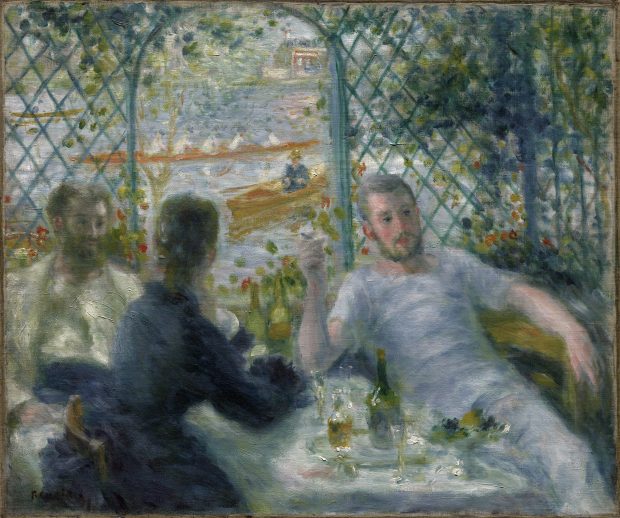In his preface for the ‘Exposition Renoir’, which took place at Bernheim-Jeune in Paris in 1913, the novelist and critic Octave Mirbeau wrote that Pierre-Auguste Renoir (1841–1919) ‘paints like he breathes. Painting has become for him the act that complements looking […] He has the optimism of all those who give themselves over entirely to the forces of nature and of instinct.’
Fast-forward 100 years and the Thyssen-Bornemisza Museum in Madrid has put together an exhibition that allows us to test these observations against six decades of Renoir’s optimistic looking. ‘Renoir: Intimacy’ is organised thematically, with rooms given over to Impressionism, commissioned portraits, everyday pleasures, landscapes, family, and bathers, and comprises more than 70 canvases from the plein air masterpieces of the 1870s to the magnificent late statements in the classical tradition.
Portrait of Madame Claude Monet, (1872–74), Pierre-Auguste Renoir. Fundaçao Calouste Gulbenkian; photo: Catarina Gomes Ferreira

Renoir once said, ‘it is the eye of the sensualist that I wish to open.’ The tactile intelligence of Renoir’s brush makes no hierarchical distinction between the delicate skin on a woman’s neck, the curling smoke from a man’s pipe, or the itchy coarseness of a tweed cap. Each stroke matters, but there are instances when the interplay between the strokes threatens to blur the distinction between people, places, and things. Renoir stated that he wanted to ‘try to create much out of little’ and in paintings like Portrait of Madame Claude Monet (c. 1872–74) and The Rowers’ Lunch (1875), the boundaries shimmer and disintegrate, only to reappear immediately thereafter. In works like these Renoir seems to be asking how little definition he can get away with before the subject dissolves altogether – as if entering into a pact with the viewer in which we are left to do the visual and emotional work of completing the composition.
The Rowers’ Lunch (1875), Pierre-Auguste Renoir. The Art Institute of Chicago

The gallery of bathers that concludes the show underscores the fact that the artist was prone to voyeurism when it came to painting women, and perhaps overly sentimental as well. But to say that all his female nudes are simply objectifications makes no allowance for the artist’s fascination with flesh as a site of painterly experimentation. In his affectionate and accommodating biography Pierre-Auguste Renoir, mon père (1962), Jean Renoir maintains that his father disclosed himself in painting landscapes devoid of the picturesque and bodies without clothing and at their best, by which I mean when they are at their most synthetic, his nudes are curious and uncanny. Elsewhere, The Promenade (1870) and Confidences (Secrets) (c. 1874) point to a delicate, respectful relationship between the sexes, and in his images of women engrossed in a shared activity, such as Young Girls Reading (1891), Renoir conveys an exclusively female world in which the participants are completely oblivious to the spectator’s presence.
Guillermo Solana, the Thyssen’s artistic director and curator of the show, suggests in the catalogue that Renoir had his brain in his hands. Painting for him was not an intellectual pursuit to be conjectured and argued over, it was a felt activity, and he harnessed his materials in order to arrive at an expressive truth. Renoir looked at things ‘as other men touch and caress’ and his work has the capacity to make us feel what we see. The artist identified the principal seat of the sense of touch in the fingertips. ‘You must protect the ends of your fingers,’ he told Jean. ‘If you expose them [through cutting your nails too short] you may ruin your sense of touch and deprive yourself of a great deal of pleasure in life.’
Renoir’s work from after his break with Impressionism – he refused to participate in the fourth Impressionist exhibition in 1878 – provokes visceral reactions. Some viewers love these ornamental and sometimes fantastical paintings while others are nauseated by them. Perhaps it is worth remembering that Henri Matisse, who often visited Renoir at his last home and studio in Provence, described The Bathers (1918–19) as one of the most beautiful pictures ever painted, while Pablo Picasso owned at least seven of the older artist’s canvases.
To my mind it is in the later work that Renoir is at his most intimate and the supreme examples of this can be found in the portraits of his family, and especially in his depictions of Aline Renoir nursing their first son Pierre. Pierre’s birth caused a revolution in Renoir’s life. Jean tells us that the art theories of the day were made to seem unimportant ‘by the dimples in a baby’s bottom’. In order to remain true to himself ‘he concentrated on rendering the velvety flesh of the child, and through this very submission, he began to rebuild his inner world’.
The first version of Aline breastfeeding Pierre is in the ‘Renoir Among Women’ exhibition, which is taking place concurrently at the MAPFRE Foundation in Barcelona, but the later copy in the Madrid show, painted by the artist in memory of his recently deceased wife, is if anything an even greater hymn to maternal love – tender, self-contained, ageless.
‘Renoir: Intimacy’ is at the Museo Thyssen-Bornemisza, Madrid from 18 October–22 January 2017.
From the December issue of Apollo. Preview and subscribe here.



